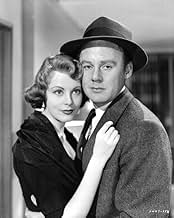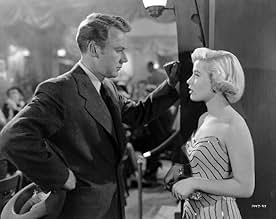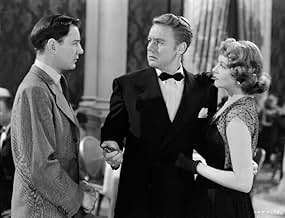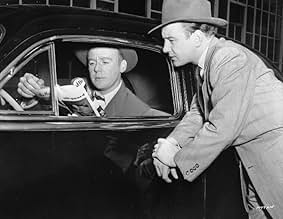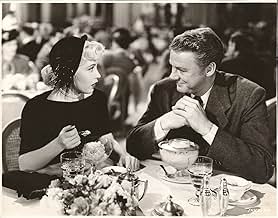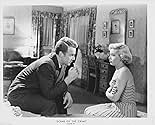AVALIAÇÃO DA IMDb
6,6/10
1,6 mil
SUA AVALIAÇÃO
Enquanto sua esposa o exorta a renunciar à força, um detetive de homicídios de Los Angeles procura o assassino responsável pelo assassinato de sua ex-namorada, que pode ter estado em contato... Ler tudoEnquanto sua esposa o exorta a renunciar à força, um detetive de homicídios de Los Angeles procura o assassino responsável pelo assassinato de sua ex-namorada, que pode ter estado em contato com os corretores locais.Enquanto sua esposa o exorta a renunciar à força, um detetive de homicídios de Los Angeles procura o assassino responsável pelo assassinato de sua ex-namorada, que pode ter estado em contato com os corretores locais.
- Direção
- Roteiristas
- Artistas
- Prêmios
- 1 indicação no total
Gloria DeHaven
- Lili
- (as Gloria De Haven)
Bette Arlen
- Girl with Sleeper
- (não creditado)
- Direção
- Roteiristas
- Elenco e equipe completos
- Produção, bilheteria e muito mais no IMDbPro
Avaliações em destaque
This is a very good film noir, well directed by Roy Rowland and with strong casting. It is based on a story called 'Smashing the Bookie Gang Marauders', which provided a run of the mill plot. But the strongest aspect of this film is its intelligent and witty screenplay by Charles Schnee. The film has many quick ripostes and lots of snappy dialogue. But unlike many such films, where gag writers have inserted the gags, there are no gags in this film, and instead Schnee has written his own text with plenty of quick zippy wit. One particularly good line is when Van Johnson says to floozy Gloria DeHaven: 'You know, when girls have your kind of looks, it's hard to see them.' That was because he had misread her character. Van Johnson is at his best as the stalwart cop in this detective tale. His beautiful wife is played by Arlene Dahl, to great effect. Gloria DeHaven is the gangster's moll, and she is some looker. She almost had me fooled too. All that soft soap concealing the hard steel underneath is enough to make any guy doubt the reliability of dames sometimes. The story concerns some wild thugs who are wiping out the bookies and killing people without compunction, in an attempt to 'take over'. The main murderer is a man with a twisted hand and a blotchy face. But no one can find him. It is interesting from the dialogue in the film that at that time tough guys did not say: 'Where is he holed up?' but merely: 'Where is he holed?' And another linguistic surprise is that Van Johnson talks of people spending time together as 'hanging', as in the phrase 'hanging out' used by young people today. I had no idea that people in 1949 were already talking about 'hanging' with each other. It all goes to show how important movies can be for one's historical education in the evolution of slang. In fact, there is no substitute for them. And that is yet another reason for watching old movies nonstop.
They're all here. Lovelorn wife, old cop trying to stick around, gangsters with neat nicknames, forensic lab work, stool pigeons, etc. There is also an uninteresting back story about a job the wife is trying to get for her husband-cop, to "keep him safe". Think of a familiar plot device and it's here in "Scene Of The Crime".
That said, this picture holds your interest - it's a good story, when all is said and done. Good acting from start to finish and there are lots of good character actors; John McIntyre, Norman Lloyd, Gloria DeHaven, Jerome Cowan, and many others. I disagree with a reviewer above in that the picture held my interest right to the end, although I am a big fan of noir films. I did think that Van Johnson was a curious choice for the title role. I always thought there wasn't a mean bone in his body, not tough enough to play a detective in a gritty noir.
Lastly, the music director was Andre Previn, and the theme music at the beginning and end was good. He also wrote two songs that were unworthy of him, but they were played in a strip joint and fit into the setting with their trite tunes and lyrics. Despite all of the preceding, I rated it a seven, which means I think it's worth your time.
That said, this picture holds your interest - it's a good story, when all is said and done. Good acting from start to finish and there are lots of good character actors; John McIntyre, Norman Lloyd, Gloria DeHaven, Jerome Cowan, and many others. I disagree with a reviewer above in that the picture held my interest right to the end, although I am a big fan of noir films. I did think that Van Johnson was a curious choice for the title role. I always thought there wasn't a mean bone in his body, not tough enough to play a detective in a gritty noir.
Lastly, the music director was Andre Previn, and the theme music at the beginning and end was good. He also wrote two songs that were unworthy of him, but they were played in a strip joint and fit into the setting with their trite tunes and lyrics. Despite all of the preceding, I rated it a seven, which means I think it's worth your time.
Two veteran Los Angeles police detectives and a well-meaning rookie set out to find the killer of an off-duty fellow officer who may have been on the take. This is an L.A. filled with dangerous broads, bookie joints, ex-bootleggers in on a new racket, and cops in natty suits and broad-billed hats. The pulpy, slangy dialogue is fun at times, as are the performances from Van Johnson and Gloria DeHaven (playing a chanteuse "with a figure like champagne and a heart like the cork"). Other, later crime-dramas would quickly up the ante on such a scenario, but this one is a fine example of the compact policer. M-G-M was downsizing their budgets at the time and trying their hand at different types of films--which provided the perfect opportunity for matinée idols like Johnson to stretch their acting muscles. The results here are not exactly noir, but more from an overtly-ordinary, overtly-jaded mold, with everyday people going about their business and getting the job done. If it isn't exciting, at least it's highly competent. **1/2 from ****
Detective Van Johnson's romantic evening out with wife Arlene Dahl is over before it's begun, when a harrowing telephone call informs him that former partner Monigan has lit his pipe for the last time, prior to being gunned down outside an illegal bookies, with $1000 in his pocket.
Accompanied by short sighted veteran, John McIntire and rookie, Tom Drake, Johnson is left to investigate a murder case tainted by allegations of police corruption. All except wacky informant, Norman Lloyd close ranks and a prolonged, arduous manhunt lies ahead.
With Arlene Dahl quaking in her high heels every time Johnson packs a rod and hits the streets, gripped by the possibility that the next time she sees him, he might be lying on a slab, the movie embarks upon a parallel route into the realms of domestic drama seen from Dahl's vantage point, illustrating the emotionally draining experience of being a cop's wife. Such is her devotion, that returning home in the small hours, with lipstick on his collar, after a 'romantic' encounter with gangster's moll and prize trollop Gloria De Haven, draws the polar opposite response to the Connie Francis treatment.
Serious soul searching starts, however, with the reappearance of ex lover, suave, debonair Tom Helmore, still carrying a torch of colossal proportions. Dahl is suddenly, painfully alerted to the safe, secure, stable and extremely prosperous life that she might have had.
'Scene of the Crime' is not a classic film noir, but as it steams along its flinty course towards the tensely violent finale, it successfully paints a contrasting picture between Johnson's unglamorous world of crime'n'grime and Dahl's no less sacrificial, contemplative, disquieting perspective on marriage to a high ranking police officer.
Accompanied by short sighted veteran, John McIntire and rookie, Tom Drake, Johnson is left to investigate a murder case tainted by allegations of police corruption. All except wacky informant, Norman Lloyd close ranks and a prolonged, arduous manhunt lies ahead.
With Arlene Dahl quaking in her high heels every time Johnson packs a rod and hits the streets, gripped by the possibility that the next time she sees him, he might be lying on a slab, the movie embarks upon a parallel route into the realms of domestic drama seen from Dahl's vantage point, illustrating the emotionally draining experience of being a cop's wife. Such is her devotion, that returning home in the small hours, with lipstick on his collar, after a 'romantic' encounter with gangster's moll and prize trollop Gloria De Haven, draws the polar opposite response to the Connie Francis treatment.
Serious soul searching starts, however, with the reappearance of ex lover, suave, debonair Tom Helmore, still carrying a torch of colossal proportions. Dahl is suddenly, painfully alerted to the safe, secure, stable and extremely prosperous life that she might have had.
'Scene of the Crime' is not a classic film noir, but as it steams along its flinty course towards the tensely violent finale, it successfully paints a contrasting picture between Johnson's unglamorous world of crime'n'grime and Dahl's no less sacrificial, contemplative, disquieting perspective on marriage to a high ranking police officer.
An off-duty Los Angeles police detective is shot and killed one night with an unexplained thousand dollars found in his pocket. It falls to his former partner (Van Johnson) to track down his killers and try to exonerate him. Scene of the Crime, which tells the story, stays a police procedural with a few twists and touches that raise it a notch or two above the routine.
First of all, Johnson's wife (Arlene Dahl) has fallen prey to the dissatisfactions common to her lot. She's tired of their evenings, in and out, being ruined by yet another summons to duty (`Whenever the telephone rings, it cuts me,' she cries); she tired of rolling his dice rigged to come up seven, a ritual that supposedly bids him luck.
On the job, he has his burdens, too. His new partner (John McIntyre) is getting on in years and his sight is failing. And under Johnson's wing is nestled rookie cop Tom Drake, learning the ropes. Outside the office there's an abrasive police reporter (Donald Woods) chasing the corruption angle; there's also the network of low-lifes who serve, if the pressure is right, as stoolies - most vivid of them is the young Norman Lloyd.
Word filters up that the killing was the work of a couple of downstate `lobos' who have been knocking over bookie operations. Going undercover, Johnson starts romancing a stripper one of them used to date (Gloria De Haven, in the movie's sharpest performance). Even though he's working her, he finds his emotions in play - and even though it turns out that she's working him, too, she has no emotions.
Under Roy Rowland's direction, Scene of the Crime keeps its plotting straightforward, though with some uncharacteristic bursts of violence. The movie's studio, Metro-Goldwyn-Mayer, was celebrated for its lavish color musicals, not for the unsentimental style of film noir. That probably accounts for the final shot's being a reconciliatory kiss, in hopes that such a sweet image might expunge all the urban squalor that went before it. Luckily, it doesn't.
First of all, Johnson's wife (Arlene Dahl) has fallen prey to the dissatisfactions common to her lot. She's tired of their evenings, in and out, being ruined by yet another summons to duty (`Whenever the telephone rings, it cuts me,' she cries); she tired of rolling his dice rigged to come up seven, a ritual that supposedly bids him luck.
On the job, he has his burdens, too. His new partner (John McIntyre) is getting on in years and his sight is failing. And under Johnson's wing is nestled rookie cop Tom Drake, learning the ropes. Outside the office there's an abrasive police reporter (Donald Woods) chasing the corruption angle; there's also the network of low-lifes who serve, if the pressure is right, as stoolies - most vivid of them is the young Norman Lloyd.
Word filters up that the killing was the work of a couple of downstate `lobos' who have been knocking over bookie operations. Going undercover, Johnson starts romancing a stripper one of them used to date (Gloria De Haven, in the movie's sharpest performance). Even though he's working her, he finds his emotions in play - and even though it turns out that she's working him, too, she has no emotions.
Under Roy Rowland's direction, Scene of the Crime keeps its plotting straightforward, though with some uncharacteristic bursts of violence. The movie's studio, Metro-Goldwyn-Mayer, was celebrated for its lavish color musicals, not for the unsentimental style of film noir. That probably accounts for the final shot's being a reconciliatory kiss, in hopes that such a sweet image might expunge all the urban squalor that went before it. Luckily, it doesn't.
Você sabia?
- CuriosidadesThis film has many actors cast against previous types. Van Johnson had appeared in light comedies and musicals, making him a teen idol at the time. His versatility, proven in this film, would lead to his role in O Preço da Glória (1949). Gloria DeHaven has previously been cast as sweet, innocent girls, but here she is a stripper and gun moll. Gorgeous Arlene Dahl, formerly a high-paid covergirl before marrying Mike, spurns the glamorous life and tries hard to accept the role the stay-at-home wife of a cop (whom she is desperately in love with, and daily fears losing).
- Erros de gravaçãoWhen Detective Piper introduces the young man that sold the .38 S&W revolver to the cop killer to detective Conovan the man says he sold the gun to a man in a bar. Conovan then assails the man over his getting a lousy eighty bucks for the gun that killed his former partner - lousy in what became of the gun, not the price, easily twice what the gun was worth. But at no time did the man or Piper mention getting that amount for the gun. It appears Piper had already reported in by phone, perhaps via CC, as Conovan did not register the least surprise at him appearing at the headquarters with the former gun owner in tow. And Conovan acted as though he already was familiar with the gist of the pickup, and was on edge and ready to talk hostilely to the young man, even threaten unlawful activities toward him.
- Citações
Sleeper: Naturally, I know you know I know somethin'.
Mike Conovan: I know you know I know you know somethin'.
- ConexõesFeatured in Some of the Best: Twenty-Five Years of Motion Picture Leadership (1949)
- Trilhas sonorasI'M A GOODY-GOODY GIRL
(uncredited)
Music by André Previn
Lyrics by William Katz
Sung (with partial striptease) by Jean Carter
Principais escolhas
Faça login para avaliar e ver a lista de recomendações personalizadas
- How long is Scene of the Crime?Fornecido pela Alexa
Detalhes
- Data de lançamento
- País de origem
- Idioma
- Também conhecido como
- La ciudad del crimen
- Locações de filme
- 259 E. 5th Street, Los Angeles, Califórnia, EUA(site of Hippo's Coffee Pot)
- Empresa de produção
- Consulte mais créditos da empresa na IMDbPro
Bilheteria
- Orçamento
- US$ 761.000 (estimativa)
- Tempo de duração1 hora 34 minutos
- Cor
- Proporção
- 1.37 : 1
Contribua para esta página
Sugerir uma alteração ou adicionar conteúdo ausente

Principal brecha
By what name was A Cena do Crime (1949) officially released in India in English?
Responda


